







The Village of Watkins Glen and community volunteers have been working on supporting this inaugural festival for the past year. We are so very excited to have you here to celebrate the inspiration of Harley J. Earl’s work on the Corvette 70 years ago! You are part of over 150 cars celebrating that legacy with this first festival!
2023 marks the 70th anniversary of the Corvette, originally designed and engineered by Harley J. Earl—inspired while attending races in 1951 at the Glen. In 1953, the first Corvette appeared at the races in Watkins Glen and 2023 marks 70 years of Corvette as the “American Sports Car.” The Village of Watkins Glen’s Parks and Recreation Department is sponsoring the Watkins Glen Corvette Festival at Clute Park and celebrating the legacy of Harley J. Earl. In short, we hope you will enjoy this rain or shine event and will spend some time in beautiful Watkins Glen.
Within this souvenir booklet, you will find the full schedule of events for this two-day festival, including the Corvette car show on Saturday at Clute Park and the Harley J. Earl Legacy Dinner and keynote address by Richard Earl. Sunday activities include 150 Corvettes lining Franklin Street for a special reenactment lap around the Original Glen Circuit.
Please seek out committee members listed here to give feedback or any congratulations:

2023 Corvette Festival Committee Chairman Craig Bond, Jerry Collins, Caitlin Cheney Watkins Glen Mayor Laurie DeNardo, Chantal Fitzgerald, Glenda Gephart, Nigar Hale, Carter Saunders, Tony Vickio, Nan Woodworth, and Kip Zeiter.
It truly “takes a village” to bring this festival to Watkins Glen to honor the legacy of Harley J. Earl and to proclaim the story of the Corvette at Watkins Glen.
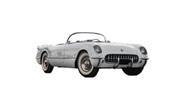
Beyond the volunteers and sponsors listed in your program, I must give a special thank you to the Watkins-Montour Rotary Club, the Glen Theatre and Watkins Glen Promotions!

Thank you for attending this first festival honoring the Corvette. We hope to see you next year!
Regards,
Craig Bond Corvette Festival ChairSuggestion boxes are located in the Seneca Lake Events Center. Please help us shape future festivals and create an even more enjoyable experience in 2024.
...the man who first envisioned Chevrolet’s two-seater sports car while in attendance at a motorsports event at Watkins Glen, and whose singular vision and design prowess transformed General Motors into the premier automobile manufacturer of the twentieth century—Harley J. Earl.”
 —Richard Earl
—Richard Earl
There are few sports cars in existence today that are more celebrated or more instantly recognizable than the Chevy Corvette. Since its historic introduction in January 1953 at GM’s Motorama extravaganza, the Corvette has been celebrated by countless millions around the globe as a legitimate world class sports car both at the racetrack and on the open road. And yet, despite its immense and unwavering popularity over the past seventy years, much of the Corvette’s origin remains one of the greatest untold stories of all time.
The same is true of the man who first envisioned Chevrolet’s two-seater sports car while in attendance at a motorsports event at Watkins Glen, and whose singular vision and design prowess transformed General Motors into the premier automobile manufacturer of the twentieth century: Harley J. Earl. While many automotive enthusiasts already know that Harley Earl contributed to the genesis of the Corvette, the enormity of Earl’s involvement with the evolution of the American automobile throughout his decades-long career at GM is arguably the greatest, never told “True Hollywood Story” of its time.
“With the possible exception of Henry Ford, no other person has single-handedly contributed more to the evolution of the modern automobile industry.” This statement by General Motors mid-twentieth-century CEO Alfred P. Sloan (from the book “Fins” by William Knoedelseder) begins to give us some context as to the scope and scale of Earl’s contributions.
Recognizing the need to embrace the sweeping tide of modern technology, Earl pioneered widespread advances in car design to usher in a new era of automobile consumerism beginning with his work on the LaSalle in 1927. Over the next decade, the unparalleled commercial success of the cars he “styled” for each of General Motors marquees (Chevrolet, Buick, etc.) would lead to his appointment as GM’s first Vice President of Styling (Design) in 1937.
Earl’s decades-long success as an artist, designer, and engineering impresario afforded him the luxury to create unique, custom automobiles for celebrities, GM executives and their wives, high-profile politicians, and other people of influence. He alone had the clout within GM to spend large sums of corporate money to build these one-of-a-kind automobiles. Similarly, his virtuosity gave him carte blanche over the styling aesthetics introduced on the vehicles his department designed to such an extent that he became “the most hated man at GM” amongst other designers and engineers alike, due almost entirely to their professional jealousy of his undeniable genius and their frustration with the authority that he alone wielded over their work.
As it is often said, “if you have haters, you must be doing something right.” When it came to automobile engineering and design, Harley was doing EVERYTHING right—and the executives at General Motors knew it.
Harley J. Earl Vice-President, General Motors Corporation from 1937 to 1958
But Earl’s contributions at GM weren’t limited to his work with the automobile. When America entered World War II, it was Earl (along with GM’s other mid-century leadership) who facilitated GM’s efforts as the largest military contractor in the world. In the years that followed the war, Earl turned his attention to the creation of GM’s Tech Center (the world’s first technology design capital) in Warren, Michigan. This epic, $125-milliondollar business facility, aptly coined the “Versailles of Industry” became ground zero for America’s technological leadership.
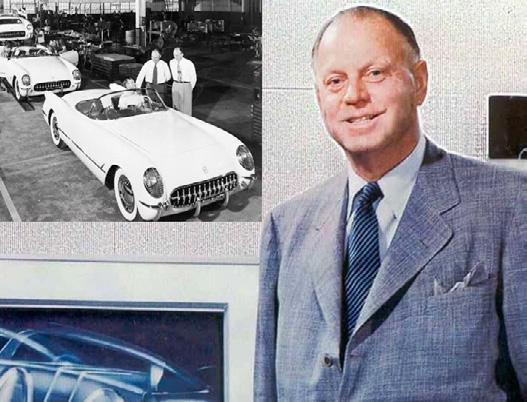
Even in the face of Harley J. Earl’s many amazing accomplishments and contributions (along with the countless others not listed here), it is the Corvette that continues to resonate most closely with consumers and enthusiasts alike. As stated on the website harleyjearl.com, “Everyone wants to talk about Corvette’s winning heritage.” However, it is virtually impossible to fully appreciate the legacy of the Corvette without understanding its genesis. It is for that reason that we invite you to join us on May 20, 2023, to experience Richard Earl’s Keynote Address “The Legacy of Harley J. Earl” as part of the First Annual “The Story of Corvette Begins at Watkins Glen” Festival.
Richard will take us on a journey through the genesis of the Corvette and Harley Earl’s role as the visionary American sports car pioneer who chose to incorporate Chevrolet’s greatly enlarged manufacturing program, together with GM’s unparalleled resources, to turn a powerful new American sports car into reality. Richard’s address will also reveal unique
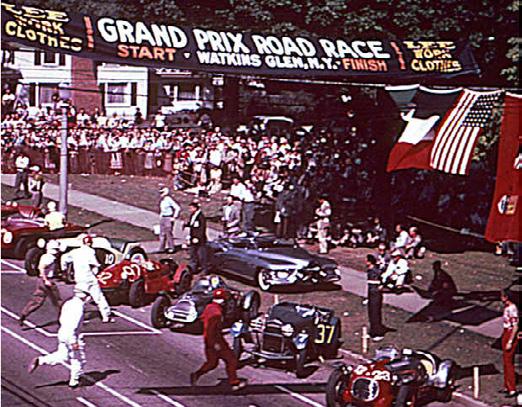
insights into the evolution of GM’s Tech Center and will reveal how Harley remained one of GM’s “best kept secrets” throughout his career. Filled with fascinating stories and several personal anecdotes, “The Legacy of Harley J. Earl” promises to offer fascinating insight into one of the greatest automotive pioneers of the 20th century!
With an auto legacy 133 years in the making, Richard is dedicated to preserving and promoting our nation’s auto heritage, especially on the roots and traditions of the Car Design profession. Today, this area is the undisputed backbone of the global automotive economy and although the legacy behind America’s Car Design Pioneer laid dormant from the 1970s into the new century, the historical narrative of Harley J. Earl is now on a much more positive trajectory. With 20-plus years spent unearthing the behind-the-scenes story (1996 to ‘06 Richard lived in Metro Detroit) and over one hundred first-person interviews later, he has become an authority on the American auto industry’s most dynamic modern leaders of the mid-twentieth century era.
Richard Earl LeSabre on start/finish line at Watkins Glen Grand Prix 1951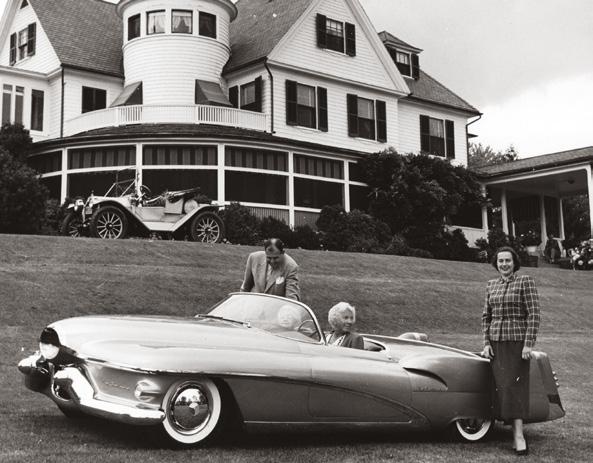


When he saw that bunch of cars at the courthouse at the start-finish line, you could see his wheels were turning, but didn’t say a thing.”
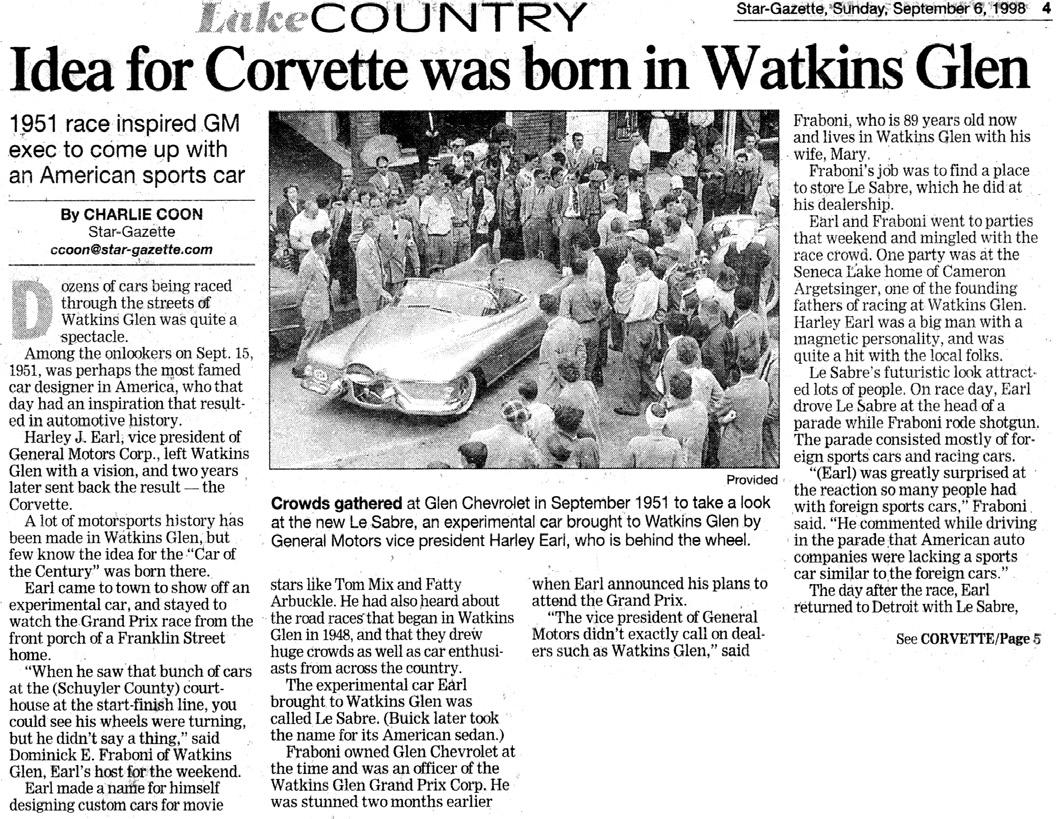 —Dominick Fraboni
LeSabre in front of Clute House, 1951.
—Dominick Fraboni
LeSabre in front of Clute House, 1951.
It’s just like when I finished the LeSabre. I’m going to show you a car right now. Let’s see, the Corvette was a little thing that I started. I ran that LeSabre up pacing a race, and then I got the idea (at) a sports car race at Watkins Glen, that’s where I got the idea for the Corvette”
—Transcript from 1954 interview, provided by Harley Earl’s grandson, Richard Earl.



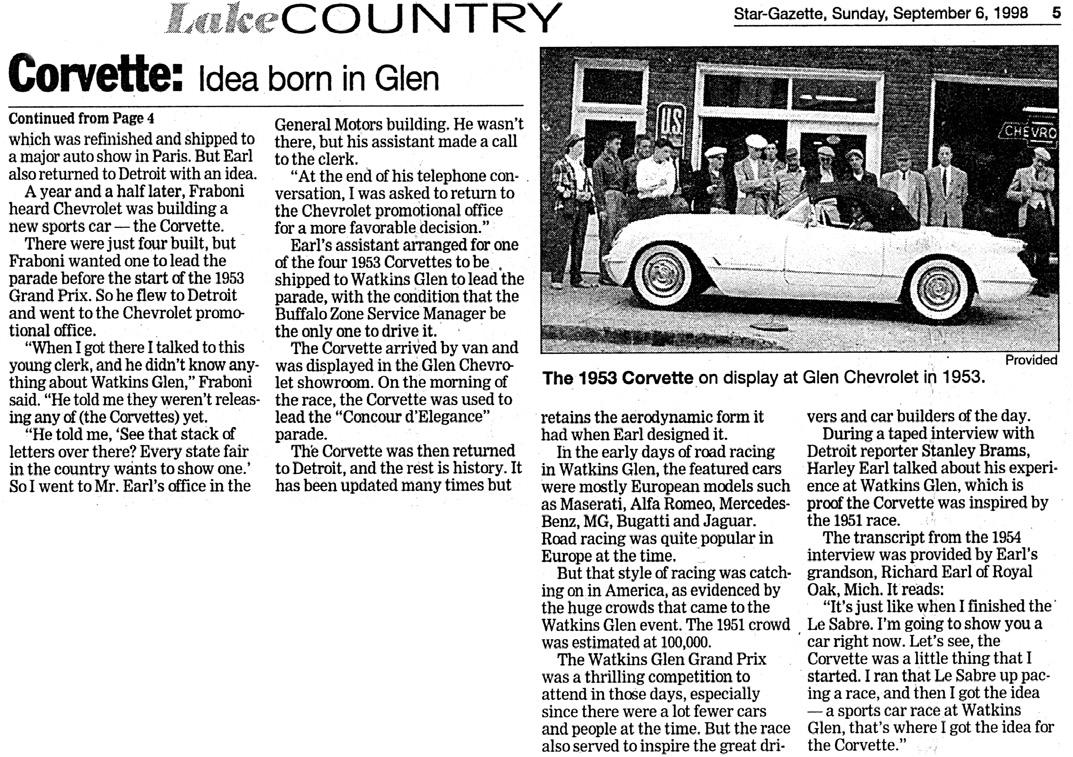
The inspiration for the Corvette came from Harley Earl's visit to Watkins Glen during the 1951 Grand Prix.
The first full-scale Corvette concept was displayed as a “dream car” at GM’s Motorama in New York’s Waldorf Astoria Hotel in January.
On June 30, 1953 the first production Corvette rolled off of the assembly line in Flint, Michigan.
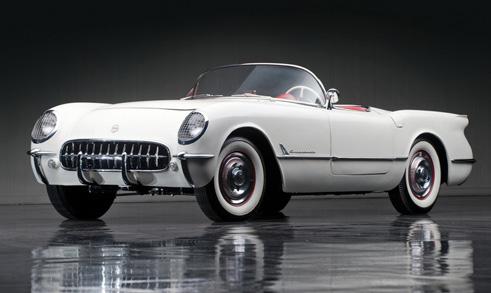
The small-block V8 displacing 265 cubic inches was introduced.
The restyled Corvette features exposed headlamps, sculpted side coves and rolled up windows. Factory-installed removable hardtops are offered for the first time.
1960 is the last year Corvette features taillights formed into rounded rear fenders and the last with heavy grill “teeth.”
The C2 Corvette is a total restyle based on Bill Mitchell’s 1959 Stingray race car.
First year ('63) for the Corvette coupe; only year for the split-window coupe. The Z06 is offered as an option on the 1963 Stingray (199 built).

Split-window design is eliminated because it “intruded into the driver’s rearward vision.”
Big Block V8 engines were introduced for the Corvette with the 396 CID L78 option. It was rated at 425 HP.
Standard features of the Corvette Stingray included an energy-absorbing steering column, four-way hazard warning flashers and a dual master cylinder brake system. Much of the exterior trim is removed or restyled, as well as the hood and fender vents.
The totally restyled C3 Corvette features an industry first for production cars—“T-top” removable roof panels. Lines of the new Corvette closely resemble those of the Mako Shark II show car. Headlamps are now of the “pop-up” design, backlit.
The 250,000th Corvette, a gold convertible, comes off the St. Louis production line on November 19. “Stingray” script is added above the fender louvers.
The 500,000th Corvette, a white coupe with red interior, is produced in St. Louis on March 15, 1977.
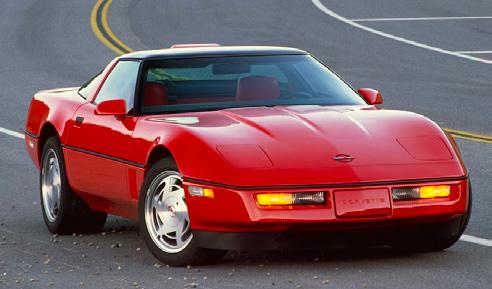
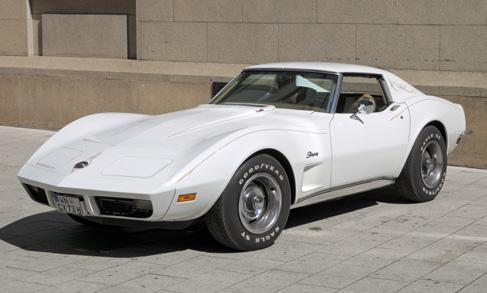
Mid-year, production shifted from St. Louis, MO to Bowling Green, KY. This was the first time a model was built in two locations simultaneously.
The all-new C4 Corvette has a drag coefficient of a 0.34, 24 percent more aerodynamic than its predecessor. Top speed over 150 MPH.
Big news for Corvette is the addition of tuned-port injection of the 230 HP 5.7 liter V8.
The first convertible since 1975 is built.
The One-Millionth Corvette, a white convertible with red interior, matching the first Corvettes of 1953, rolls off the Bowling Green assembly line on July 2, 1992.
Corvette paces the Indy 500 for the third time in 1995 (first in 1978, also in 1986).
Corvette featured hydroformed side frame rails, each made of a single piece of tubular steel. Transmission was rear mounted.
For the first time since 1962, a separate trunk with outside access returned on the Corvette convertible.
A hardtop model with permanently-fixed roof panel and external trunk lid joins the Corvette family.

Optional heads-up display offered.
50th Anniversary of the Corvette is marked by the availability of a 50th Anniversary package with special red paint, a unique two-tone shale interior, special emblems and Magnetic Selective Ride.
Special commemorative package honoring Corvette’s success at Le Mans are available. Corvette paced the Indy 500 in 1998.
All new design (C6) and engineering. Powered by the new 6.0L 400 HP small block V8. Exposed headlights return for the first time since 1962.
Power top option for convertibles for the first time since 1962. OnStar and navigation available for the first time. Corvette paced the Indy 500.
Z06 Carbon Limited Edition offered to mark Corvette’s 50th anniversary at Le Mans. Exteriors limited to Supersonic Blue or Inferno Orange.
Chevrolet Centennial Edition (available on all models), featuring Carbon Flash metallic paint, satin-black graphics, satin-black cup wheels with red stripe, unique badges, special-trimmed interior with red stitching and Magnetic Selective Ride Control.
60th Anniversary and a special 427 convertible Collector Edition close out the C6 generation on a high note.
The seventh generation C7 Corvette is introduced at an invitation-only reveal in Detroit on January 13, 2013 . The Stingray designation returns.
Indy 500 is paced by a 2014 Laguna Blue Corvette Z51 driven by San Francisco NFL coach Jim Harbaugh.
Aluminum frames become the standard for all coupe and convertible models.
Michelin becomes the exclusive tire supplier for Corvette.
The Stingray features a LT1 V8 engine with 460 HP making it the quickest, most powerful standard Corvette to date.

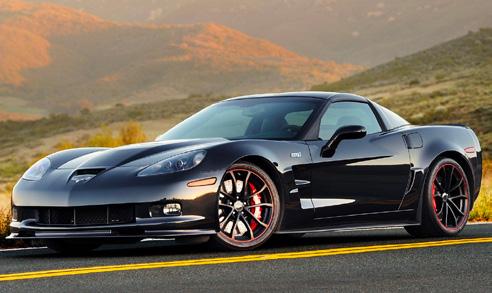
The C8 Corvette debuted with an 8-inch infotainment screen in a driver centric cockpit. It comes standard with Chevrolet's Infotainment 3 Plus system. Standard features include Bluetooth connectivity, 4G hotspot, and both Android Auto and Apple CarPlay.
Higher trims are equipped with a 14-speaker Bose audio system and navigation options. Additional technology features include a performance data recorder package for 2LT and 3LT trim levels as well as a camera based rear view mirror.
The 2020 Corvette was the first year Chevrolet introduced over the air updates to the Corvette line-up. This allows Chevrolet to send updates to the vehicle remotely. Chevrolet used this capability to resolve a front trunk recall for the 2020 Corvettes.


1953—1955 The source of inspiration for this C1 logo came from the founder of Chevy, Louis Chevrolet and the French roots of his family name. This is where the exemplary fleur-de-lis (flower of the lily) emblem first appeared.

There were five variations of crossed flags on C1 Corvettes. For 1956 & ’57, the design had restyled flags and a chevron in front of the flags. From 1957-’60, the crossed flags were restyled and didn’t have the circle or lettering. For 1961, the crossed flags were restyled and included a chevron. And lastly, in 1962, the crossed flags were restyled with the chevron and a red, white and blue bar inserted above.
This generation introduced in 1963 was designed specifically for the Stingray model. The emblem still featured an image with two crossed flags, just like on the previous version. As for the lettering, it was set in two lines, with the black cursive “Corvette” set above the white sans-serif “Sting Ray” written on a black horizontallyoriented rectangle, and underlined by a thick black line.
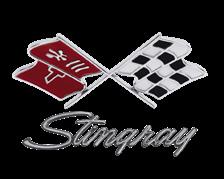

The Corvette emblem embraces the race-track-inspired specs of this Corvette model and the family history of Chevrolet, and is known the world over. In 1953, Robert Bartholomew designed the first Corvette logo using the American flag and the finishline flag. The American flag had to be dropped due to laws concerning its use in advertising.

The new emblem for the Mako Shark Corvette was bold and no longer featured a circle border or any words. The two crossed and molded flags matched the much bolder stance of the new model. This logo was in place until 1984 when the next generation Corvette was introduced.
From 1983 through 1996, the Corvette logo reintroduced the circle and created a much more modern version of the flags without waving or flag poles. The fleur-de-lis was also removed and the checkered flag was placed on the left side with the Chevy bowtie on a red background on the other.
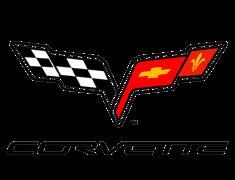
The 5th generation logo ran from 1997 through 2004 and featured a return of the fleur-de-lis with the bowtie on the same red background beside the checkered flag and inside a glossy black circle with black flag poles. This is a sleek logo that
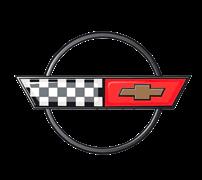

From 2005 to 2013 a streamlined version without the circle or flag poles emerged. This logo still featured the bowtie and fleur-de-lis across from the checkered flag. Now it looks neater and more laconic, the circle is removed again.
The Corvette logo from 2014 features futuristic bold forms and lines of the flags. There is no circle outline and the emblem gains a triangular shape. The logo looks sleek and modern. The logo features the flags stretched and meeting in the middle to create


New Corvette logo is designed for the C8 Corvette and features the same two crossed flags, composing the letter “V” but in stronger and sharper lines. It looks powerful and energetic. The fleur-de-lis symbol is also slightly modernized.

Friday, May 19
6:00 pm–8:00 pm
Informal Meet and Greet with Richard Earl Watkins Glen Harbor Hotel Bar
Hosted by Watkins Glen Area Chamber of Commerce
Saturday, May 20
7:30 am–9:45 am
Registration Begins
Pick up registration packets at Clute Park. Packets contain: dinner tickets, movie pass, car registration # for windshield, souvenir booklet, schedule of events, People’s Choice ballot, T-shirt voucher, extra materials from outside organizations
9:00 am
Parking For General Public
$10.00/car
10:00 am–5:00 pm
Corvette Car Show at Clute Park
10:00 am–5:00 pm
Events Center
Vendors are set-up; T-Shirt pickup
11:00 am–5:00 pm
Food Vendors Open
Lucky Hare Brewing (near splash pad)
Great Escape Ice Cream
BC’s Food Truck
Bucket Bar & Grill
Horseheads Brewing
Lakewood Vineyards
2:00 pm–5:00 pm
Music Trick Shot the Band
5:30 pm
Community Center Cash bar opens
6:00 pm
Harley J. Earl Legacy Dinner Dinner begins—open seating at Community Center
6:45 pm
International Motor Racing Research Center
Introduction of Richard Earl
7:00 pm
Richard Earl Keynote Speech
Announcement of People’s Choice Awards
8:00 pm
Community Center Closes
Sunday, May 21
9:00 am–11:00 am
Optional breakfast—Seneca Harbor Station
$19.99/person
Pre-registration only
10:00 am
Pre-Registered Corvettes park along Franklin Street before street closure at 11:00 am
11:00 am
Franklin Street closed from 2nd to 10th Street, traffic is diverted until reenacted lap. Businesses are open
Noon—Showing #1
“25 Years at Speed, The Watkins Glen Story” at Glen Beacon Theatre. Drivers depart to cars on Franklin Street
12:30 pm—Showing #2
“25 Years at Speed, The Watkins Glen Story”

12:30 pm–1:45 pm
Cars Line Up
Tony Vickio and 150 Corvettes


Sheriff’s Official Escort to Start/Finish Line
1:45 pm
International Motor Racing Research Center
Introduction of Richard Earl
1:55 pm
Richard Earl
Tribute to Tony Vickio at Schuyler County Court House
1:59 pm
Wave the Green Flag
From the start/finish line at Schuyler County Court House
2:00 pm
Reenacted Lap of Historic Original Watkins Glen Circuit
2:30 pm





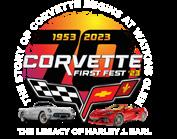


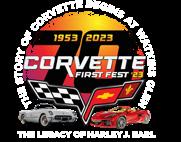


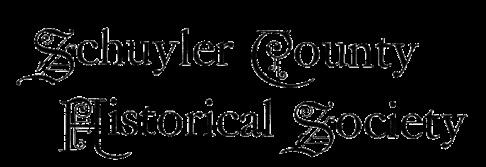
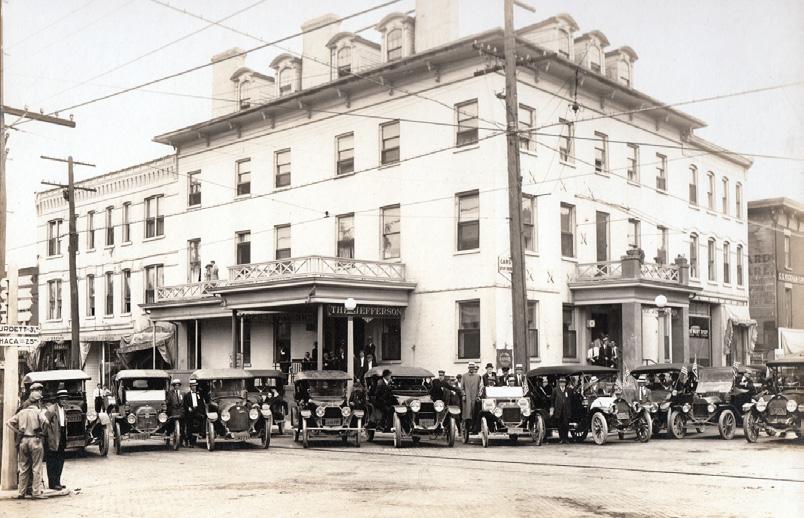



Proud car owners like you have been gathering in Watkins Glen for more than 100 years!
September 7-10, 2023
2023 marks the 75th anniversary of racing at Watkins Glen as well as the 70th birthday of the Corvette. It seems only fitting that these two events…as intertwined as they are…should be celebrated together during The Glen’s Vintage Weekend September 7-10, 2023.
While Watkins Glen is widely acknowledged as “The Birthplace of American Road Racing,” a story that is not as universally known is that the village and its racing heritage also served as the inspiration for “America’s Sports Car,” the Corvette.
Harley Earl, head of General Motors Design came to The Glen in 1951 to display the LeSabre concept car at the sports car races being held through the streets of the village. While the LeSabre was greeted with much enthusiasm, Earl was overwhelmed by the excitement of the 150,000+ fans cheering the European cars as they raced around the course. Earl returned to Detroit convinced that America needed a car to compete on the international stage. His “inspiration” became the Corvette and that inspiration was born on the streets of Watkins Glen!
Thursday, September 7
Friday, September 8–10th
Lakewood Vineyards FLX Corvette Journey.
30th Annual Watkins Glen Grand Prix Festival in downtown Watkins Glen grandprixfestival.com. This event annually attracts 10,000–12,000 fans to a day-long celebration of the early days of racing through the streets of the village. Corvette will be the featured marque for the Festival in honor of its 70th birthday. A special display of Corvette race cars from many eras will highlight the marque’s rich history of racing at The Glen.
Saturday, September 9
Saturday—Sunday, September 8–10
The IMRRC, racingarchives.org, will host an evening Corvette Symposium open to all fans of the marque.
Hilliard U.S. Vintage Grand Prix. SVRA race event at the famed Watkins Glen International circuit. The Corvette race cars will move to the track for a special “Corvette Corral” display on Saturday and Sunday.
We cannot honor the marque without also paying homage to the man. A commemorative bench and plaque will be placed on Franklin Street—part of the original circuit—honoring Mr. Earl and telling the story of his 1951 visit. Discussions are ongoing to bring the LeSabre back for the first time since that memorable 1951 visit, and bringing to full circle the story of Harley Earl—Watkins Glen—Corvette—Watkins Glen Corvette Festival honors Harley Earl. It’s a “75 /70” Celebration

